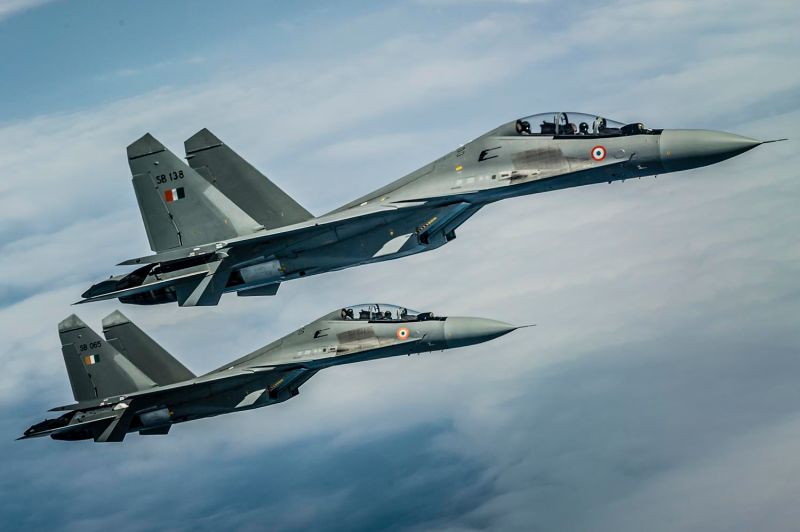Indian Su-30 MKI fighter jets are in news after Hindustan Aeronautics Limited (HAL) announced that it had inked a contract with Bharat Electronics Limited (BEL) for the co-development and co-production of a long-range dual-band Infrared Search and Track System (IRST) for the Russian-origin Sukhoi warplanes.
As part of the ‘Make in India’ initiative, the deal was signed under the MAKE-II procedure of Defense Acquisition Procedure 2020.
Projects in the ‘Make-II’ category will involve prototyping equipment, systems, and platforms, as well as their upgrades and subsystems/sub-assemblies/ assemblies/ components. However, there is no government funding allocated for prototype development.
The long-range dual-band IRST system will be deployed onboard Indian Air Force (IAF) Su-30 MKI multirole fighter aircraft, according to a statement made by HAL on April 26.
“The proposed IRST system will be a high-end strategic technology product in the field of defense avionics and technically competitive to existing IRST system in the global market with features of Television Day Camera, Infrared & Laser sensors in a single window for air-to-air and air-to-ground target tracking and localization,” HAL said in a release.

The system will have features of Television Day Camera, Infrared & LASER sensors in single window for air to air and air to ground target tracking and localization. The system will enhance the Indian Air Force’s air superiority.
— ANI (@ANI) April 26, 2022
The system will enhance the air superiority of the Indian Air Force. According to the statement, the joining of two defense PSUs for the development of technologically critical IRST gives a boost to ‘Atmanirbhar Bharat’ in the defense industry.
The device will be able to operate in both day and nighttime circumstances, greatly enhancing the aircraft’s capabilities.
Former Indian Air Force (IAF) pilot Vijainder K Thakur told The EurAsian Times, “The Long Range Dual Band Infrared Imaging Search and Track System (IRST) for SU-30 MKI being developed by HAL & BEL will feature Focal Point Array (FPA) sensors in two bands. It will facilitate improved target recognition and better discrimination of the target from background IR radiations.”

Objects radiate heat at different IR wavelengths. Dual-band IRSTs increase target identification, tracking, and clutter rejection, he noted.
“Typically, a dual-band IRST would operate in the 8-12 µm LWIR band and 3-5 µm MWIR band. Hot objects such as exhaust ports and engine plumes are more pronounced in the MWIR, while airframes, fuselages, and missile hard bodies are more pronounced in the LWIR. Water vapor absorption dominates in the LWIR, while carbon dioxide absorption dominates in the MWIR. Solar reflections are significant in the MWIR but suppressed in the LWIR,” according to Thakur.
Infrared Search & Track System
The IRST allows fighter planes to identify and track enemy planes based on their heat signatures and then engage them with heat-seeking air-to-air missiles. IRS is usually installed on all modern aircraft, either on the airframe in front of the canopy or on the belly.
The device also allows aircraft to track hostile aircraft without exposing themselves to passive detection by avoiding the use of radars. The aircraft with a longer IRST range and a longer air-to-air missile would dominate the battlefield.
Under the Defense Procurement Procedure (DPP) 2016, India’s Ministry of Defense (MoD) had first requested the development of an indigenous IRST system. In 2017, the government issued a questionnaire for Indian companies interested in developing this system.
Companies were asked to ensure 40 percent Indigenous Composition (IC), according to the questionnaire (IC). Automatic tracking, ground target identification, video data output, and direct connection to the aircraft’s Multi-Function Display are among the technical requirements.
The developers were also asked if the system would necessitate any structural changes to the Su-30 MKI. Nonetheless, this program will bolster the domestic defense sector’s capabilities and give the Su-30 MKI a boost in performance.

Thakur also highlighted the major advantage of the domestically produced IRST, saying, “an indigenous IRST would accrue from the fact that its operating software would be home coded, allowing for improvements, better sensor fusion (correlation of IRST targeting data with the targeting data obtained from an AESA radar and/or another sensor) & direct integration with weapon systems. For example, it would be possible to directly feed IRST output to air-to-air missile sensors before launch!”
Altogether, this project paves the way for the future development of IRST’s high-end strategic technological products for multiple platforms in a worldwide competitive environment in the sphere of indigenous defense manufacture.
- Contact the author at ashishmichel@gmail.com
- Follow EurAsian Times on Google News




